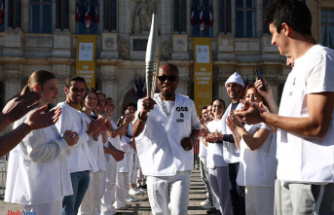"The Locomotive" has a firm place in the history of athletics. Long-distance runner Emil Zatopek sets 18 world records in his career. His wife Dana is also an Olympic champion - at the same time as him. And the two have even more in common.
It was probably one of the most touching moments in Olympic history: in Helsinki in 1952, Czechoslovak running legend Emil Zatopek and his wife Dana passionately embraced in front of the cameras. "It was a beautiful kiss," she said later. He had just won the marathon after the 5,000 and 10,000 meters - a phenomenal triple triumph. And she won gold in the javelin with 50.47 meters.
In addition to their sporting zeal and their love, the two spouses also connected the date of birth. Emil Zatopek was born in Koprivnice on September 19, 1922, his future wife Dana was born on the same day in Frystat, 40 kilometers away. This is now being commemorated in the Czech Republic with exhibitions, concerts, school competitions and the unveiling of a statue. He died in November 2000, she almost 20 years later.
A bronze figure of Zatopek stands in the garden of the Olympic Museum in Lausanne. The four-time gold winner also set no fewer than 18 world records. He was the first to run the distance of ten kilometers in less than 29 minutes in Brussels in 1954. On the 5000-meter distance, he undercut the time of the legendary Swede Gunder Hägg in Paris with 13:57.2 minutes. As early as 1951, it exceeded the mark of 20 kilometers in an hour.
His sluggish but powerful running style earned Zatopek the nickname "the locomotive". He was making faces, bobbing his head, looking anything but elegant. He is said to have rejected criticism with the comment: "You know that this is neither gymnastics nor figure skating."
His training methods were no less unusual. He ran in heavy boots to feel lightness in the actual competition. Or he carried his wife Dana on his back for stadium laps. Back then, Zatopek discovered the benefits of interval training. His motto was: "You can't take it anymore? Then step on the gas!"
Almost a year ago, a feature film about the star athlete was released in the Czech Republic, simply called "Zatopek". The actor Vaclav Neuzil prepared for the leading role with years of running training and lost around ten kilos in weight. "When you say the name Emil Zatopek, people first think of willpower, perseverance, determination and diligence," says the 42-year-old, who lives in Prague.
What motivated Zatopek? He found his freedom and independence with running, says Neuzil. In fact, Zatopek grew up in poor circumstances as the second youngest child of eight siblings. Before he joined the army and devoted himself entirely to sports, he worked rather unhappily in the Bata shoe factory in the eastern Moravian industrial city of Zlin.
Some historians criticize that Zatopek allowed himself to be co-opted by the then socialist regime in Czechoslovakia. He joined the communist party KSC in 1953 and later worked under the alias "Macek" as an employee of the military counter-intelligence service (VKR). It is not known what exactly this cooperation consisted of.
After the invasion of Warsaw Pact troops in August 1968, Zatopek fell temporarily out of favor for criticizing the regime. For a few years he had to make ends meet as a laborer in a well drilling operation.
"I don't think he intentionally harmed anyone," says Zatopek actor Neuzil about the controversy. At the same time, the top athlete knew that he would not have achieved what he wanted without the support of those in power. Neuzil said: "He was a very extroverted and own person, but also very vulnerable - and an eternal little boy."












